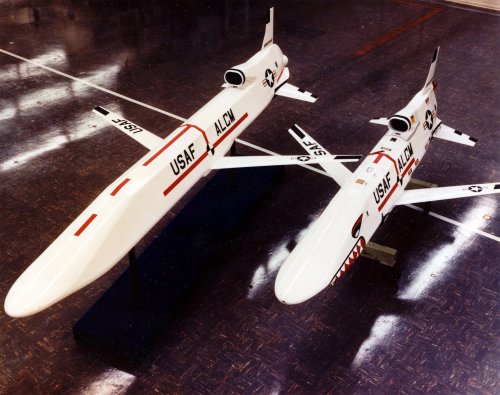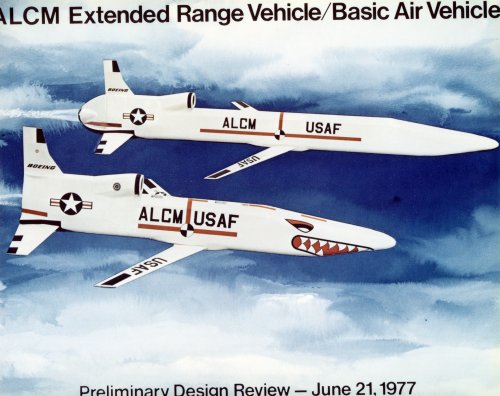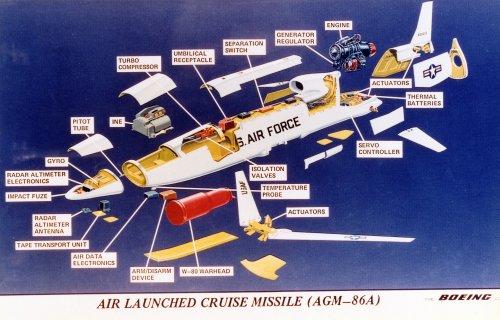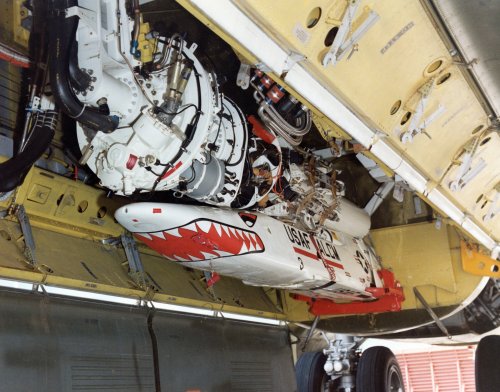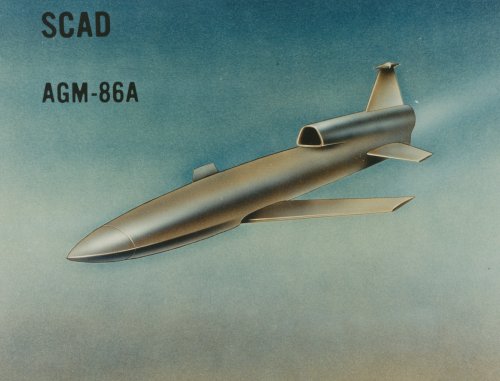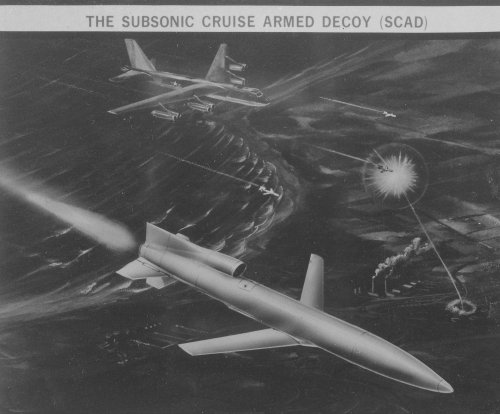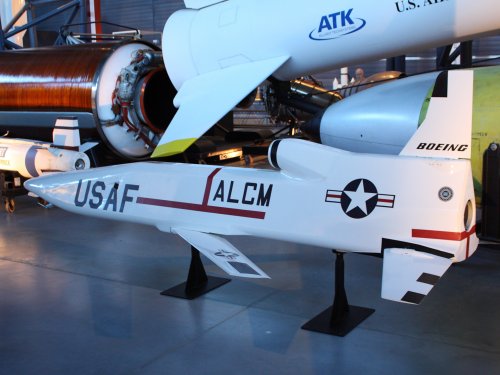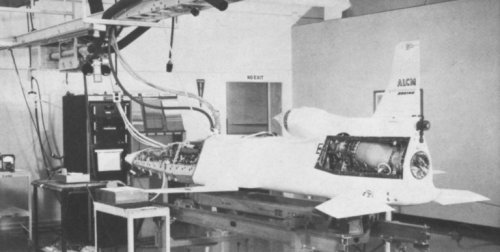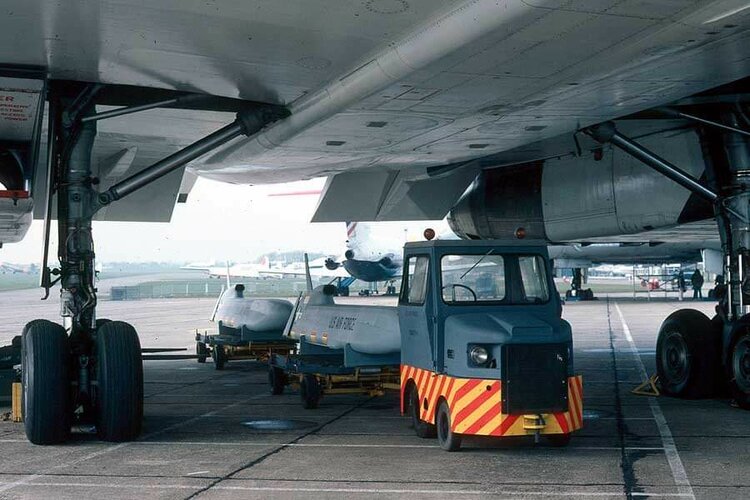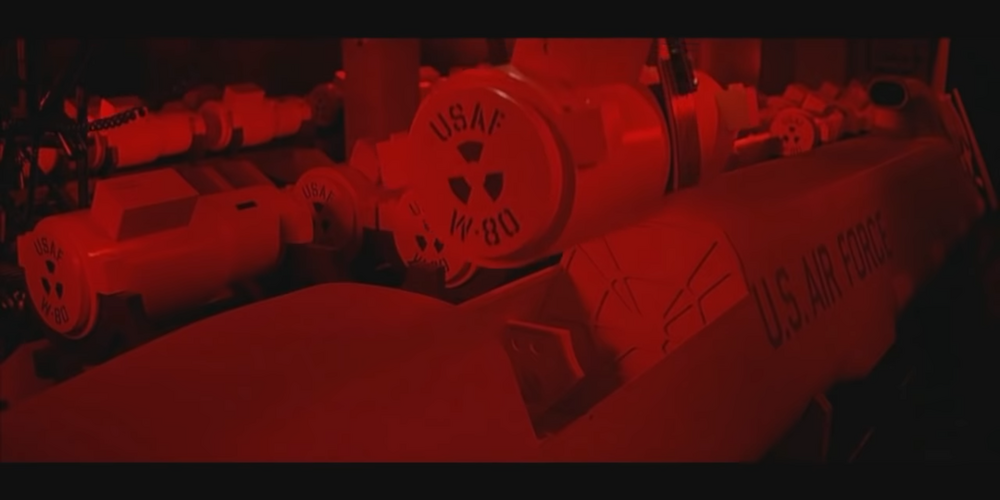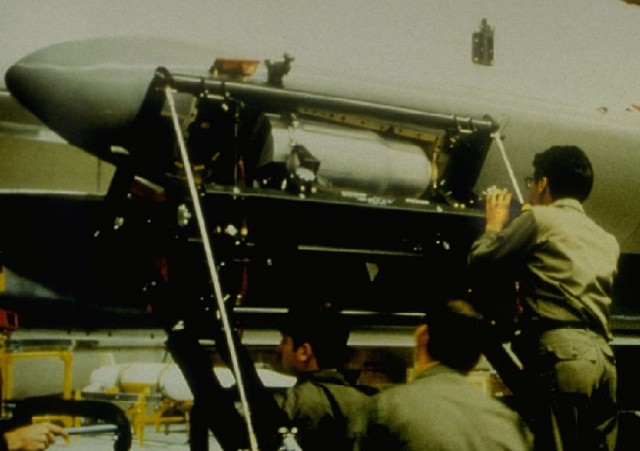You are using an out of date browser. It may not display this or other websites correctly.
You should upgrade or use an alternative browser.
You should upgrade or use an alternative browser.
Early ALCM studies - ZAGM-86A and AGM-86B
AGM-86A ALCM (Air Launched Cruise Missile) undergoing final pre-delivery tests at the Boeing plant.
Source:http://www.ausairpower.net/TE-Cruise-Missiles-1985.html
Source:http://www.ausairpower.net/TE-Cruise-Missiles-1985.html
Attachments
- Joined
- 9 October 2009
- Messages
- 20,457
- Reaction score
- 11,194
A 1974 AFIT thesis called "The In-House Management Approach: An Analysis of the Subsonic Cruise Armed Decoy Program". (DTIC link)
apparition13
I really should change my personal text
- Joined
- 27 January 2017
- Messages
- 502
- Reaction score
- 872
Just a quick note on the AGM-86A from Goetz's "A technical history of america's nuclear weapons: volume II - developments from 1960 through 2020 - second edition":
Length: 167.25 inches, (13'11.25", 4.24 meters)
Wingspan: 115 inches at 35 degrees,
Weight: 2082 pounds,
Speed: Mach 0.65-0.85,
Range: 650nm
They were about the same size as SRAM, so the B-1 could carry up to 24 of them internally.
I was looking for range, and couldn't find it online when I remembered I had the book. No index, which made it more difficult, but a useful book nonetheless.
That's a size and weight that would have made them tactical aircraft friendly. I'd say they would be better than a B-61 for attacking tactical targets, as would the SRAM 2, the intended replacement for the B-61. The warhead was around 300lbs, so substituting a conventional munition wouldn't yield much bang, but range could be sacrificed for payload.
Length: 167.25 inches, (13'11.25", 4.24 meters)
Wingspan: 115 inches at 35 degrees,
Weight: 2082 pounds,
Speed: Mach 0.65-0.85,
Range: 650nm
They were about the same size as SRAM, so the B-1 could carry up to 24 of them internally.
I was looking for range, and couldn't find it online when I remembered I had the book. No index, which made it more difficult, but a useful book nonetheless.
That's a size and weight that would have made them tactical aircraft friendly. I'd say they would be better than a B-61 for attacking tactical targets, as would the SRAM 2, the intended replacement for the B-61. The warhead was around 300lbs, so substituting a conventional munition wouldn't yield much bang, but range could be sacrificed for payload.
Last edited:
Yellow Palace
ACCESS: Top Secret
- Joined
- 5 May 2007
- Messages
- 1,146
- Reaction score
- 1,976
The original AGM-86A was a really interesting concept to be used by penetrating bombers, allowing them to attack multiple targets off their flight path and acting as an armed decoy. The later B version was really an alternative concept looking to avoid penetration entirely, less adaptable to alternative applications but a response to the political-military concerns of the time around penetrating bombers.That's a size and weight that would have made them tactical aircraft friendly. I'd say they would be better than a B-61 for attacking tactical targets, as would the SRAM 2, the intended replacement for the B-61. The warhead was around 300lbs, so substituting a conventional munition wouldn't yield much bang, but range could be sacrificed for payload.
- Joined
- 27 December 2005
- Messages
- 16,722
- Reaction score
- 20,509
In-house ASD (Wright Patterson) ALCM study.

Splendid Vision, Unswerving Purpose: Developing Air Power for the United States Air Force During the First Century of Powered Flight
2002
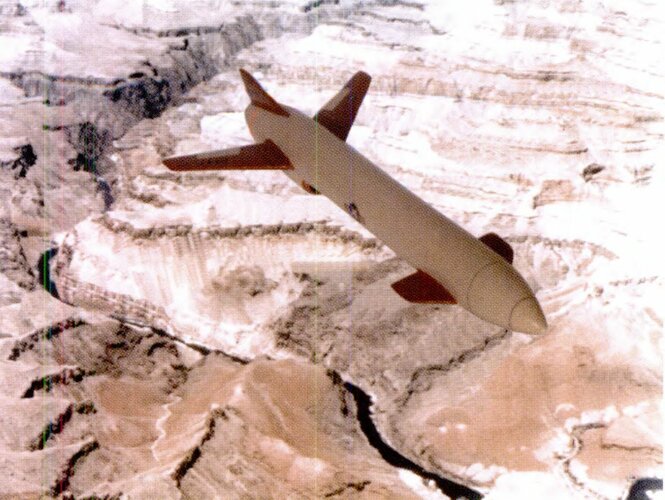
Early preliminary design studies of the ALCM included the Subsonic Cruise Attack Missile (SCAM), the Subsonic Cruise Armed Decoy (SCAD), and the Subsonic Cruise Unarmed Decoy (SCUD), the latter a replacement for the Quail decoy, all of which began as design studies by Wright Field's design engineers. ASD's Development Planning deputate worked with both the Air Force Avionics Laboratory and the Air Force Aero Propulsion Laboratory in developing the ALCM concept. Particularly vital was the projection of engine technologies for gas turbine power plants that were sufficiently small for use in a missile. After many years of further development studies in the Air Force and the Department of Defense, the AGM-86 ALCM achieved operational status in 1982.
Splendid Vision, Unswerving Purpose: Developing Air Power for the United States Air Force During the First Century of Powered Flight
2002
Last edited:
- Joined
- 9 October 2009
- Messages
- 20,457
- Reaction score
- 11,194
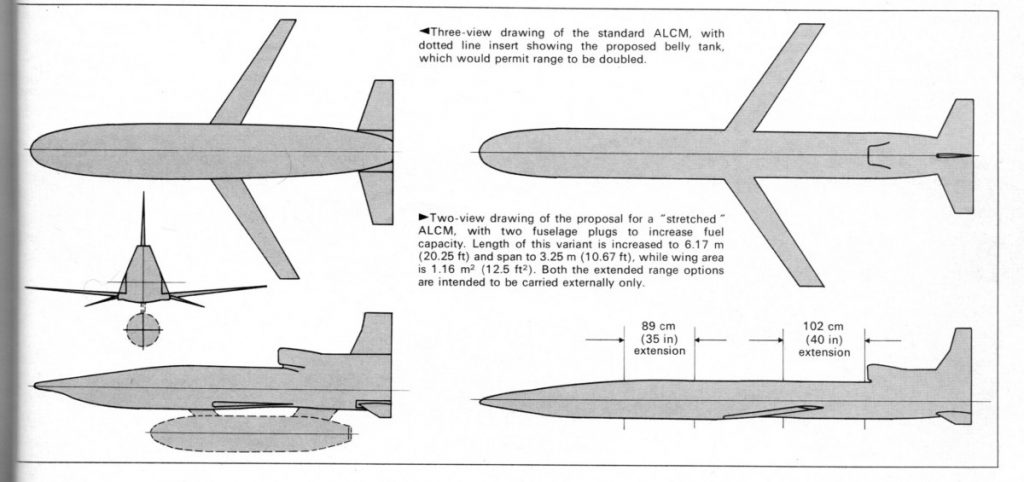
Extended (early) ALCM - The Unwanted Blog (2)
The model AGM-86 Air Launch Cruise Missile began life as a decoy missile, sort of an updated “Quail.” it was decided that the […]
 unwantedblog.com
unwantedblog.com
- Joined
- 9 October 2009
- Messages
- 20,457
- Reaction score
- 11,194
Going a bit OT for a moment, here is one of the ALCM's first cameos in fiction (as as well a B-1A cameo). From the 'unofficial' 1983 James Bond film Never Say Never Again.
View: https://www.youtube.com/watch?v=E7wjw95oN3I&t=5m39s
View: https://www.youtube.com/watch?v=NqaO0c4wzWQ
Last edited:
Tomahawk missile fan
ACCESS: Restricted
- Joined
- 19 September 2022
- Messages
- 34
- Reaction score
- 36
W80 nuclear warhead steal on AGM-86 ALCM.
The film gives a fairly accurate representation of an AGM-86B however what they did get wrong is how the W80 is loaded into the missile.
Last edited:
- Joined
- 14 June 2006
- Messages
- 2,297
- Reaction score
- 446
Now we are getting nearer the real ancestor of the ALCMs, and of all the modern (i.e. Seventies on) air breathing, air launched cruise missiles. The real ancestor was the CLAMP, Chemical Air Launched Missile Puny. After my very old post somewhere here, I am delighted to see CLAMP cited in the new Scott's work on US supersonic bomber projects talking about the GD Configuration 2120 AMPSS. CLAMP were intended as an alternative primary armament (four of them) housed in the rear bomb bay (one Mk-53 or four Mk-43 were the free-fall options). CLAMP were massive than the ALCM, remeber they were intended to be suersonic. The forward bay housed 9 SRAM-like missile. The available GA drawing of the GD aircraft shows a missile different from the real SRAM. I suggest, since the timeframe (June 1964) that this was a concept studied under the LASRM program.
This is the best I can conclude now. LASRM offspringed the concepts going to the ASALM.
This is the best I can conclude now. LASRM offspringed the concepts going to the ASALM.
Last edited:
- Joined
- 1 April 2006
- Messages
- 10,889
- Reaction score
- 7,502
Vintage Boeing SCAD B-52 Air Launched Decoy Missile Illustration Prints + Data | #4554062349
Vintage Boeing SCAD B-52 Air Launched Decoy Missile Illustration Prints + Data sheet.Yes, combine and save on shipping.
Attachments
-
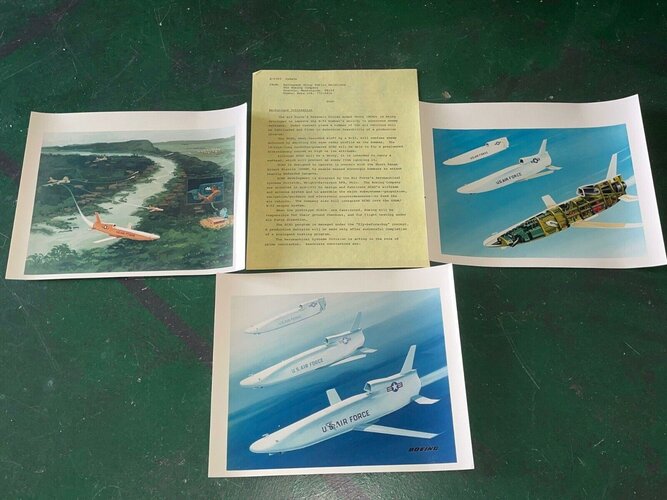 1_822dd365da15cd84e5e43f5c2da092c8.jpg267.1 KB · Views: 35
1_822dd365da15cd84e5e43f5c2da092c8.jpg267.1 KB · Views: 35 -
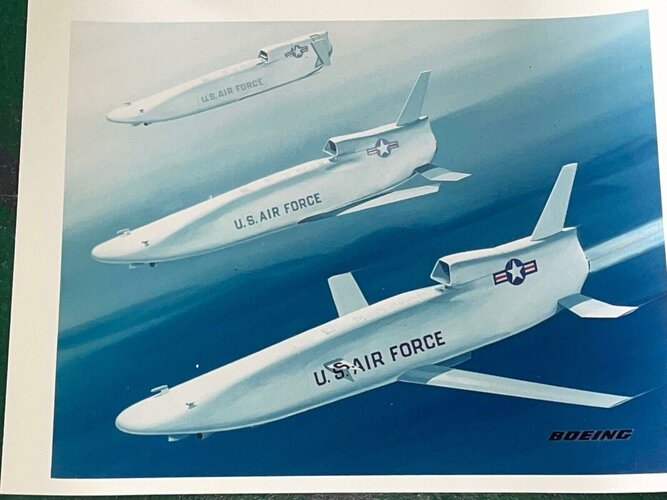 1_822dd365da15cd84e5e43f5c2da092c8 (4).jpg205.4 KB · Views: 43
1_822dd365da15cd84e5e43f5c2da092c8 (4).jpg205.4 KB · Views: 43 -
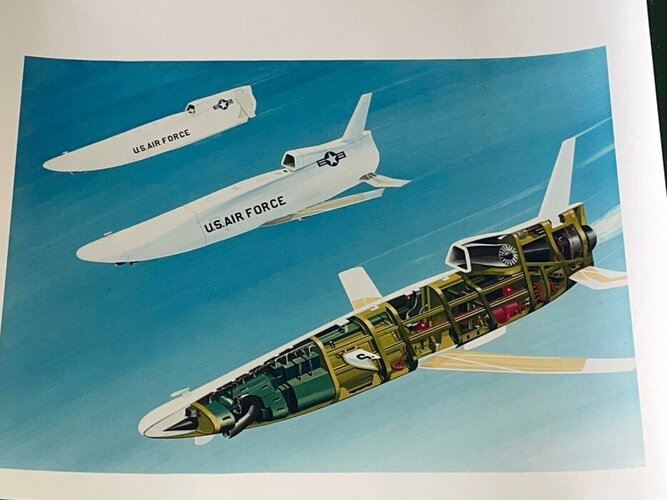 1_822dd365da15cd84e5e43f5c2da092c8 (2).jpg223.4 KB · Views: 46
1_822dd365da15cd84e5e43f5c2da092c8 (2).jpg223.4 KB · Views: 46 -
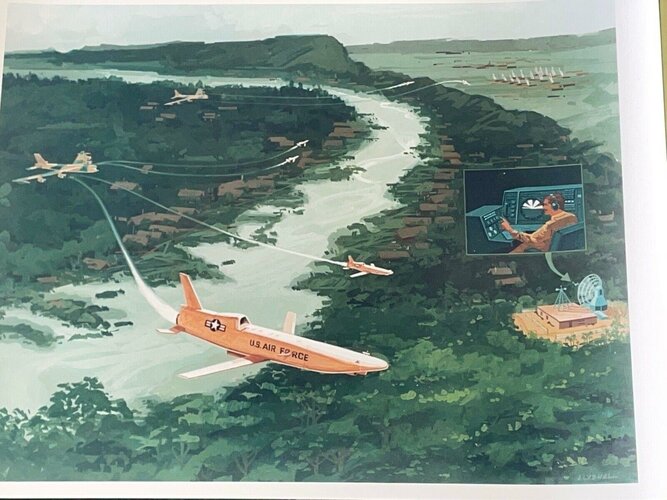 1_822dd365da15cd84e5e43f5c2da092c8 (1).jpg259.8 KB · Views: 50
1_822dd365da15cd84e5e43f5c2da092c8 (1).jpg259.8 KB · Views: 50 -
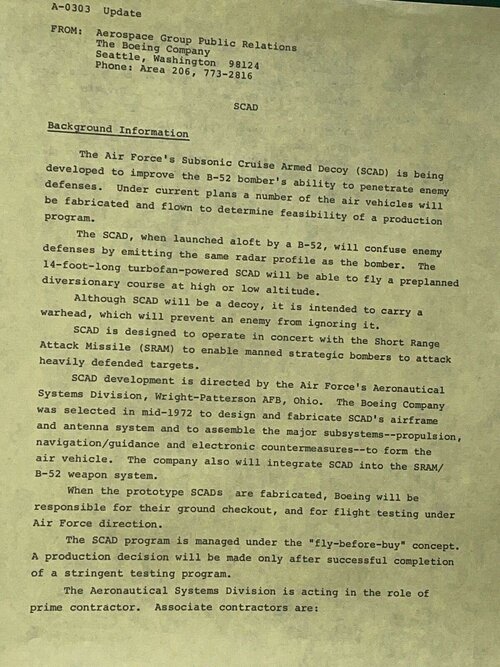 1_822dd365da15cd84e5e43f5c2da092c8 (3).jpg360.5 KB · Views: 47
1_822dd365da15cd84e5e43f5c2da092c8 (3).jpg360.5 KB · Views: 47
Scott Kenny
ACCESS: Above Top Secret
- Joined
- 15 May 2023
- Messages
- 7,355
- Reaction score
- 6,930
For a stubby CALCM, I'd definitely want as close to a 1000lb warhead as I could get. I suspect that the range would end up down under 300nmi. In either case, you'd need a much more accurate guidance system to be useful, probably DSMAC early on and then some flavor of imaging via datalink as component sizes came down.Just a quick note on the AGM-86A from Goetz's "A technical history of america's nuclear weapons: volume II - developments from 1960 through 2020 - second edition":
Length: 167.25 inches, (13'11.25", 4.24 meters)
Wingspan: 115 inches at 35 degrees,
Weight: 2082 pounds,
Speed: Mach 0.65-0.85,
Range: 650nm
They were about the same size as SRAM, so the B-1 could carry up to 24 of them internally.
I was looking for range, and couldn't find it online when I remembered I had the book. No index, which made it more difficult, but a useful book nonetheless.
That's a size and weight that would have made them tactical aircraft friendly. I'd say they would be better than a B-61 for attacking tactical targets, as would the SRAM 2, the intended replacement for the B-61. The warhead was around 300lbs, so substituting a conventional munition wouldn't yield much bang, but range could be sacrificed for payload.
And I'm still amazed and confused at how the ALCM fuselage is mostly big die-cast chunks, not light weight stressed skin. Probably made the ALCM a lot cheaper to make than building it like a Cessna...
I just took a look at the Wiki pages for the SLAM and SLAM-ER, and I think a stubby CALCM would have been a significantly better choice than the Harpoon-based SLAM/ER. Yes, the SLAM/ER are lighter, but even a 300nmi stubby CALCM would have far better range than SLAM-ER. And you're not really losing any weapons capacity, any pylon carrying a SLAM is only carrying one missile. At worst you'd be short some fuel due to MTOW limits, which you fix by hitting a tanker before the strike departs.
Similar threads
-
-
-
ASD Preliminary Designs in Splendid Vision, Unswerving Purpose
- Started by XP67_Moonbat
- Replies: 16
-
-

